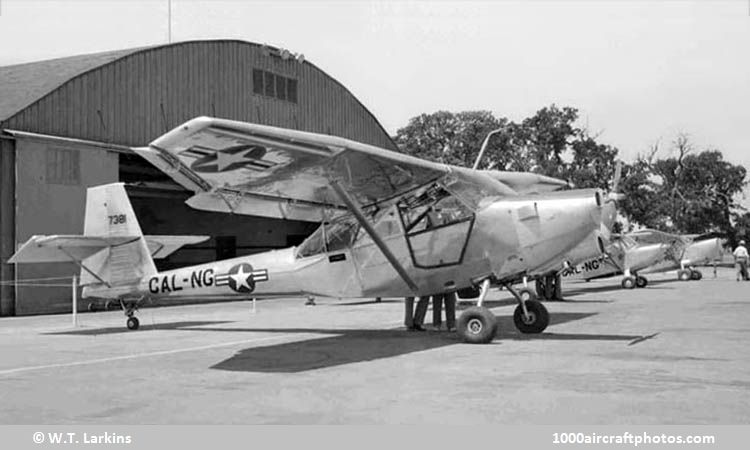04/30/2015. Remarks by Johan Visschedijk: "Designed by the Stinson Division, the Model 105 was intended as a follow on to the L-5 series. Powered by a 245 hp Franklin O-425-5 flat-six air-cooled engine, this all-metal general liaison, observation, and ambulance aircraft featured wings that folded back alongside the fuselage, a tail plane that folded upwards, and landing wheels which swivelled round and toed inwards to ease ground handling. The high-lift, two-spar wing of airfoil NACA 43012A was in two sections, each with 25 sq.ft (2.32 sq.m) of trailing edge area, slotted flaps and a fixed leading edge slot. Without removing the two-blade variable-pitch wooden propeller, the aircraft could be towed in glider fashion at up to 150 mph (241 kmh) and released in flight, offering a substantial increase in range. Normal crew complement was two side-by-side and a third aft, but up to six could be carried in an emergency. Two doors were installed on the starboard side and one on the port side and the windows sloped outwards to improve vision. Skis or floats could be fitted.
Two prototypes were built by Stinson at Wayne, Michigan under the USAAF designation XL-13 (serialed 45-58708, 45-58709), and flight tests resulted in an order for 300 L-13As (s/n 46-68 to 46-213, 47-267 to 47-420) built by Consolidated Vultee (Convair) at San Diego with the 250 hp O-425-9 engine, 48 aircraft went directly to ANG units. Following tests with the sixth production aircraft (s/n 46-73), 28 aircraft (s/n 46-110 to 46-111, 47-395 to 47-420) were converted to L-13B standard for Arctic use with the installation of a special combustion heater and ducting.
In the mid-1950s, surviving USAF aircraft were disposed of as surplus. A restricted certificate (AR-10) was issued to Lester Branchflower, Burbank, California, for stock L-13As, but as this category limited sales several conversions were undertaken by others. The Longren Aircraft Co, Torrance, California, bought a number of surplus L-13s and converted one L-13B, registered N4901V (c/n 282, ex 47-402), as a six-seat bush aircraft in the standard licensing category called the Centaur 101 in 1958 with additional fin area and a 300 hp Lycoming R-680-E3 radial engine. The actual modification was undertaken by C. Roger Keeney's ACME Aircraft, also at Torrance, who also fabricated a few Centaur 100s, and subsequently, the Centaur 102 was also produced with a Jacobs R-755-A2 engine.
Caribbean Traders Inc. in Miami, Florida converted a number surplus L-13s as Husky Is (250 hp Franklin O-425-9), Husky IIs (300 hp Lycoming R-680-13), and Husky IIIs (450 hp Pratt & Whitney R-975-7). All models except the Husky I featured a swinging engine mount and quick-disconnect firewall fittings for easy maintenance and a constant-speed Hamilton Standard metal propeller replaced the original airscrew. Husky IIs were used by at least two airlines, Compañia Dominicana de Aviación (registered HI-28 and HI-31) and SATGA - Société Aérienne de Transports Guyanna-Antilles (registered F-OGAS) based at Cayenne, French Guiana. The latter flew to Martinique, Guadeloupe and other islands in the Lesser Antilles chain, and into a 300 ft (91 m) strip in French Guiana to supply a mining operation (a twenty-minute flight over a one-week journey by boat, horse, and foot). Other Husky IIs were sold in Mexico and Bolivia."
